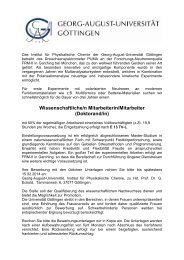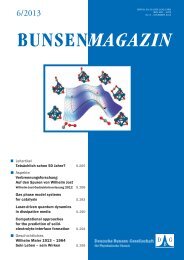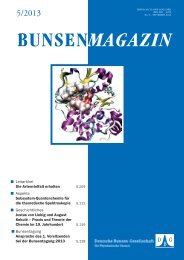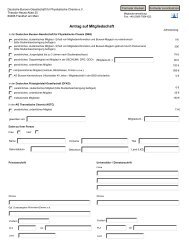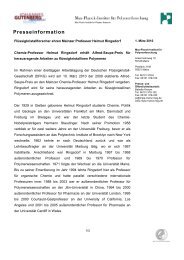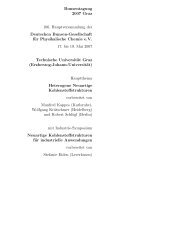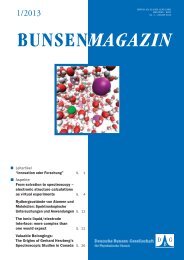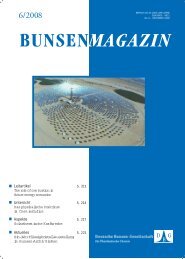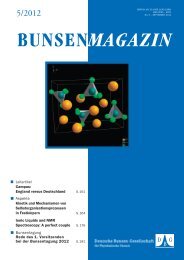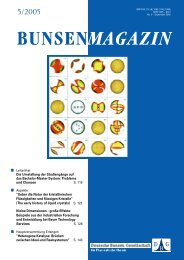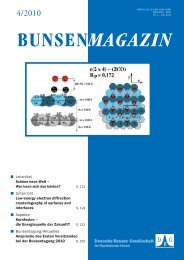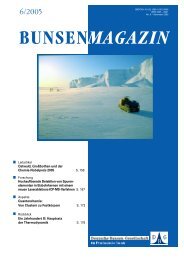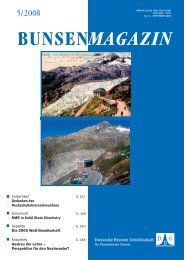BUNSENMAGAZIN - Deutsche Bunsengesellschaft für ...
BUNSENMAGAZIN - Deutsche Bunsengesellschaft für ...
BUNSENMAGAZIN - Deutsche Bunsengesellschaft für ...
Sie wollen auch ein ePaper? Erhöhen Sie die Reichweite Ihrer Titel.
YUMPU macht aus Druck-PDFs automatisch weboptimierte ePaper, die Google liebt.
UNTERRICHT<br />
titania, where the PO(OH) 2 moiety is known to tightly bind to<br />
ZrO 2 surfaces. While in the bulk diacids, only hydrogen-bonded<br />
homodimers (head-to-head, tail-to-tail) are present, hydrogenbonding<br />
among carboxylic and phosphonic acid groups (headto-tail)<br />
is found in multilayers of the diacids on ZrO 2 nanopowder.<br />
Notably, the monolayers appeared less ordered compared<br />
to respective multilayers, possibly due to a superposition of<br />
intramonolayer and interparticle hydrogen-bonding. 80<br />
4. CONCLUSION<br />
Highly resolved solid-state MAS NMR spectra of supramolecular<br />
organic systems can nowadays be recorded on rather<br />
small amounts (10 - 15 mg) of as-synthesized compounds.<br />
The methodology, however, can be applied in general. For instance,<br />
double-quantum fi ltered heteronuclear correlation experiments<br />
have been used to selectively study interactions of<br />
water molecules and solid microcrystalline proteins, which play<br />
a major role in protein folding, structure, and function. Notably,<br />
the experimental data revealed no evidence for solid-like water<br />
molecules, thus indicating that residence times of solvent molecules<br />
in the proximity of the protein are shorter than required<br />
for DQ creation. 82 Similarly, heteronuclear dipolar couplings can<br />
be exploited for the structure determination of transmembrane<br />
proteins. 83 In the fi eld of metabonomics, proton double-quantum<br />
fi lter have been applied for the quantifi cation of highly relevant<br />
γ-aminobutyric acid (GABA) levels in the human brain. 84<br />
Furthermore, in earlier studies, high resolution DQ MAS NMR<br />
spectroscopy of isotopically labelled systems yielded torsional<br />
angles in peptides 85,86 and thus important information about<br />
the chain conformation. In addition, the secondary structure<br />
and topology of an entire seven-helix receptor protein in a native<br />
membrane environment could be determined via both<br />
homonuclear dipolar correlation and heteronuclear scalar correlation<br />
MAS NMR spectra. 87 High-resolution solid-state NMR<br />
also facilitated an assessment of structural features that defi<br />
ne interfaces among proline-rich motifs that are frequently<br />
involved in signaling events. 88 The sensitivity of 1 H chemical<br />
shifts to ring currents in aromatic systems has been exploited<br />
in determining the packing of porphyrines. 89 The full information<br />
about distances and the relative orientation of specifi c<br />
moieties is available from DQ-NMR spectroscopy on static<br />
samples of specifi cally labeled materials 90 and has provided<br />
important information about the chain conformation and the<br />
packing of synthetic macromolecules. 91<br />
The development of the technique is far from being complete. 55<br />
Major advances are expected in the years to come so that solid<br />
state NMR is envisaged to become a rather indispensable tool<br />
in macromolecular, supramolecular and biological science as<br />
is solution state NMR today.<br />
This work highly benefi ted from fi nancial support of the <strong>Deutsche</strong><br />
Forschungsgemeinschaft (DFG) (SFB 625).<br />
72<br />
BUNSEN-MAGAZIN · 11. JAHRGANG · 2/2009<br />
1 a) R. Devanathan, Energy & Environmental Science 2008, 1, 101-<br />
119; b) B. Lafi tte, P. Jannasch, Advances in Fuel Cells 2007, 1,<br />
119-185; c) J. Schauer, Current Trends in Polymer Science 2006,<br />
10, 19-26.<br />
2 a) N. Peyghambarian, Optics & Photonics News 2005, 16, 31-35; b)<br />
N. Peyghambarian, R. A. Norwood, Optics & Photonics News 2005,<br />
16, 28-33; G. A. M. Gigli, R. Cingolani, G. Barbarella, Advanced<br />
Semiconductor and Organic Nano-Techniques 2003, 2, 241-291.<br />
3 W. J. Kim, S. W. Kim, Macromolecular Research 2007, 15, 100-<br />
108.<br />
4 Encyclopedia of Materials: Science and Technology, Pergamon,<br />
Amsterdam, 2001.<br />
5 A. J. Wilson, Annual Reports on the Progress of Chemistry 2008,<br />
104, 164-183; b) S. Yagai, A. Kitamura, Chem. Soc. Rev. 2008, 37,<br />
1520-1529.<br />
6 J. M. Lehn, “Supramolecular polymer chemistry - scope and perspectives.”<br />
in Supramolecular Polymers, pp. 3 - 27; CRC Press LLC,<br />
Boca Raton, 2005.<br />
7 B. J. Berne, R. Pecora, Dynamic Light Scattering, Dover, Mineola,<br />
2000.<br />
8 B. E. Warren, X-Ray Diffraction, Dover, Mineola, 1990.<br />
9 J. S. Higgins, H. C. Benoit, Polymers and Neutron Scattering, Oxford<br />
University Press, Oxford, 1997.<br />
10 a) L. C. Sawyer, D. T. Grubb, Polymer Microscopy Springer, Heidelberg,<br />
1987; H. J. Butt, M. Kappl, Surface and Interfacial Forces,<br />
Wiley VCH, Weinheim, 2009.<br />
11 I.M. Ward, J.Sweeney, An Introduction to the Mechanical Properties<br />
of Solid Polymers, Wiley, Chichester, 2004.<br />
12 F. Kremer, A. Schönhals, (Eds.) Broadband Dielectric Spectroscopy,<br />
Springer, Heidelberg, 2002.<br />
13 a) S. P. Brown, H. W. Spiess, Chem. Rev. 2001, 101, 4125 – 4155;<br />
b) D. Reichert, Annual Reports NMR Spectroscopy 2005, 55, 159<br />
– 203; c) H. Eckert, S. Elbers, J. D. Epping, M. Janssen, M. Kalwei,<br />
W. Strojek, U. Voigt, Topics in Current Chemistry 2005, 246, 195<br />
– 233; d) S. E. Ashbrook, M. E. Smith, Chem. Soc. Rev. 2006, 35,<br />
718 – 735.; e) S. P. Brown, Prog. Nucl. Magn. Reson. 2007, 50, 199<br />
– 251; f) R. K. Harris, P. Jackson, L. H. Merwin, B. J. Say, G. Hagele J.<br />
Chem. Soc. Faraday Trans. 1988, 84, 3649 – 3649; g) R. K. Harris,<br />
Solid State Sci. 2004, 6, 1025 – 1037; h) F. Taulelle Solid State Sci.<br />
2004, 6, 1053 – 1057; i) R. K. Harris, The Analyst 2006, 131, 351<br />
– 373.<br />
14 A. M. Orendt, J. C. Facelli, Annual Reports on NMR Spectroscopy<br />
2007, 62, 115 - 178.<br />
15 K. Schmidt-Rohr, H. W. Spiess, Multidimensional Solid State NMR<br />
and Polymers, Academic Press: New York, 1994.<br />
16 B. Blümich, NMR Imaging of Materials, Clarendon Press, Oxford,<br />
2000.<br />
17 a) R.R. Ernst, G. Bodenhausen, A. Wokaun; Principles of Nuclear<br />
Magnetic Resonance in One and Two Dimensions, Clarendon Press,<br />
Oxford, 1987; b) A. Abragam, The Principles of Nuclear Magnetism,<br />
Clarendon Press, Oxford, 1961.<br />
18 a) M. H. Levitt, Spin Dynamics – Basis of Nuclear Magnetic Resonance,<br />
Wiley, Chichester, 2008; b) M. Mehring, Principles of High<br />
Resolution NMR in Solids, Springer, Berlin, 1983.<br />
19 H. Eckert, Bunsenmagazin (2008), Jg. 10, H. 5, S. 159 – 179.<br />
20 a) S. Hafner, H. W. Spiess, Concepts Magn. Reson. 1998, 10, 99 -<br />
128; b) S. Dusold, A. Sebald, Annual Reports on NMR Spectroscopy<br />
2000, 41, 185 - 264.



